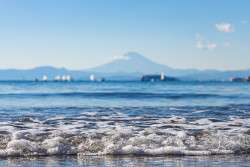
May 26, 2006
Cape Tribulation
Explore Australia’s wild side on the coast north of Cairns
By Metropolis
Originally published on metropolis.co.jp on May 2006

Photos by Simon Rowe
Stairway to heaven or highway to hell? it is a matter of opinion for those brave travelers who take a tour bus driven by a garrulous, sunburned Queenslander up the Captain Cook Highway to experience Australia’s far north.
The perils of paradise are not to be taken lightly. They include a barge crossing of the crocodile-infested Daintree River, muddy-tasting roadhouse coffee, highway-hopping cane toads, and the odd diesel-coughing sugarcane truck with a top speed of 50km/hr.
But the cold sweats and strange roadside popping noises of the Cook are a distant memory as soon as one reaches a crest where the jungle abruptly falls away and the brilliant blue Coral Sea and its white-fringed beaches are revealed. Then, it is a short, jiggly descent into that long-awaited destination—the township of Cape Tribulation.
Much of this region remains as it was when Captain James Cook surveyed it bleakly from his ship Endeavour in 1770. The British navigator couldn’t have imagined that this vast damp carpet of jungle spilling from the mountains down to the sandy beaches was in fact one of the world’s oldest—about 110 million years old. Only the rainforest of the Amazon basin is known to be older.
Neither farmers nor chainsaw-welding timbermen have since succeeded in taming this ancient morass. After violent confrontations between the timber industry and environmentalists in 1988, a World Heritage listing was prescribed for Cape Tribulation National Park and the greater Daintree Rainforest region, in order to protect the rare flora and fauna thriving there.

It is not everyone’s cup of cane juice, however: swarms of insects, sweltering temperatures and a sticky reddish soil that finds its way into everything, including the coffee, ensure that less-adventurous tourists never make it past the swimming-pool bars of Port Douglas, north of Cairns.
Yet for harried city slickers and many international travelers who come to lap up the excess of oxygen, spend their days exploring the forest trails, and gorge on tropical fruit grown by the entrepreneurial locals, it is indeed “heaven on earth.”
Cape Tribulation’s handful of permanent residents eke out lean lifestyles from industries like horticulture and tourism. With its minimal facilities—a petrol station, two shops and a handful of self-sufficient tourist resorts—the village is just the kind of place you expect to rub shoulders with these modern-day Robinson Crusoes.
Digby Gotts fits that profile. The tall, bushy-bearded former schoolteacher came to Cape Tribulation with his wife in 1986, en route from Melbourne to Darwin, and was instantly enamored with the region, its isolation and tropical climate.
After more than a decade of seed collecting, they run an orchard that numbers more than 2,000 trees and includes species from the Amazon, Southeast Asia and the Caribbean. The fruit goes by names like jaboticaba, wax jambu and the vanilla-flavored ice-cream bean—words most Sydney city fruit sellers have never heard before in their lives.

Curious visitors can join one of Gotts’ daily afternoon tastings and hear about the origins, characteristics and preparation of such exotic fruit as the Latin-American sapodilla, which tastes like caramel, or the chocolate pudding fruit from Mexico that tastes a lot like… well, you know.
From April through to October, the skies over Cape Tribulation remain relatively clear, and the sea breezes blow warm and dry. But as November approaches, the billowing thunderheads that gather far out over the Coral Sea begin racing shoreward, heralding the arrival of the wet season. From December to March, travelers can expect daily showers and humidity levels above 80 percent, though don’t expect the same volume of rain that locals saw during the flood of 1996, when 1.5m fell in 36 hours. But pack a lightweight umbrella all the same.
“They don’t call this region the ‘Wet Tropics’ for nothing. What would a rainforest be without its daily downpour?” asks longtime Cape Tribulation resident and forest guide Paul Mason as we wait out an afternoon deluge beneath a grove of towering fan palms. Together with his son Lawrence and a team of knowledgeable guides, Mason offers day and night walking tours to travelers keen on learning more about the region’s unique ecosystems.
The jungle is quite literally their backyard; Mason’s 170-hectare property shares its boundary with the Daintree National Park and the Wet Tropics World Heritage Area, meaning those who undertake a half-day tour have a good chance of glimpsing rare fauna like the cassowary, an ostrich-like bird that grows as tall as 180cm, and ancient flora like MacIntyre’s Boxwood, a tree species estimated to be around 2,600 years old.
Beyond Cape Tribulation winds the long and torturous Bloomfield Track to Cooktown, the last bastion of civilization in far-north Queensland and a further 100km by 4WD vehicle. Swimming off the coastal beaches is possible during the summer months, when marine stinger jellyfish are not present, though during the wet season, extreme caution is advised to avoid these deadly sea creatures.
And while a dip in a clear stream or waterfall above the coastal Bloomfield Track will bring life back to even the most pink-broiled tourist, the wizened locals advise not to test the waters of the estuaries below the road. “Big Salties,” or estuarine crocodiles, inhabit these murky inlets and have even been sighted by fishermen on the reef itself.
Doesn’t Cape Tribulation have its own Crocodile Dundee, you ask? Thankfully, you will find none of those types around here.
Australian Airlines (http://australianairlines.com.au) flies twice daily direct to Cairns from Tokyo. To get to Cape Tribulation, rent a car in Cairns and do the 2.5hr drive yourself. Or look up one of the dozens of tour operators along Cairns’ Esplanade for a bus/bed package. Once in Cape Trib, head for PK’s Jungle Village bar, where backpackers mingle nightly with the wild-and-woolly bush folk over stubbies (bottles) of frosty Victoria Bitter. (For more info on Mason’s Tours guided rainforest walks, see www.masonstours.com.au) A guided tour of Cape Trib Exotic Fruit Farm, with tasting, costs AU$15 (¥1,200). See www.capetrib.com.au for more info. Try the Coconut Beach Rainforest Lodge for privacy with your own patch of rainforest; rates begin at $370 per night for one of the 27 Daintree Retreats (3 persons) or 39 freestanding Rainforest Retreats (four persons). Tel: 61-2-9339-1040, www.coconutbeach.com.au
[geo_mashup_map]







